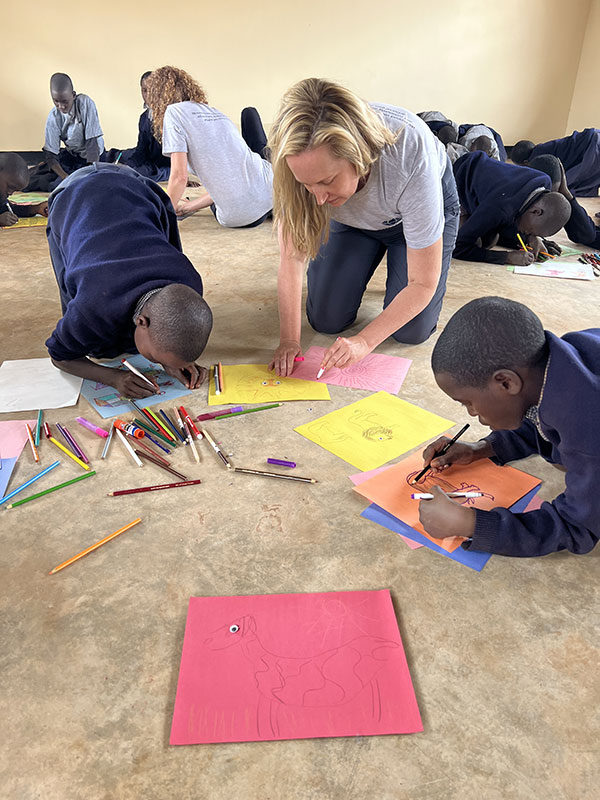
Rachel (née Dery) Merisheki, executive director of Gem Legacy, a Detroit-based nonprofit that supports vocational training, entrepreneurship, and community development in East African artisanal gem mining communities, wants prospective donors to the organization to know one thing:
“One hundred percent of our donations go directly to our initiative,” she tells JCK. “We don’t take any fees. We were originally able to fund it with annual contributions from our board members, but to grow, you have to put something in. If we were speaking at an event and wanted to print business cards, or pay for a domain name, it was not feasible anymore.”

To support administrative costs, the nonprofit, founded five years ago by Merisheki’s father, the gem dealer Roger Dery, created a spinoff, for-profit company called Gem Legacy Adventures that takes people to Kenya and Tanzania on annual excursions to visit mines and community development projects. Think of it as a travel outfitter with a charitable twist.
“The goal was to fund the nonprofit but kind of kill two birds with one stone,” says Merisheki. “As we looked at our donor list, 80 percent of our top donors have all traveled to East Africa and experienced the mining regions. We decided we’d build more passionate donors if they had the opportunity to see everything firsthand.”
The first Gem Legacy Adventure took place in the summer 2022. And just last August, the organization completed its second trip. A third trip is planned for Aug. 3–13, 2024. “You have to work around the trade show schedule and around the rainy season at these mines, so summer is best,” Merisheki says.
What can people expect from the adventure? “A lot of people are like, Africa? Is it scary? Is it dangerous?” she says. “We walk you through everything: what to pack, what not to pack, cultural norms, how to greet people. It’s a very, very different culture.

“You’ll have some eye-opening moments,” she adds. “The credibility you have when you can say, ‘I’ve actually been to a colored gemstone mine, here are the challenges, here’s what they’re really good at.’ The miners love their work and it invigorates people who’ve been in the industry for decades. And now you have this story to tell about a place you’ve seen firsthand. You can be part of that conversation about where colored gemstones come from and the positive impact they have.”
The itineraries differ year to year, but going forward, the trips, which last 10 days, will begin in Nairobi before moving south to Voi, then crossing over the border into Tanzania by car, and coming to a close in Arusha, with departures out of Kilimanjaro.
The goal is to provide participants a taste of what it’s like to work with Gem Legacy.
“We want it to feel as organic as possible,” Merisheki says. “This summer we delivered tool kits to mines. There’s a fine line between supporting a mine and investing in a mine. We work really hard to find the right mines that need this kind of support. We tell them, ‘This is a gift, no strings attached.’”
A sample itinerary typically includes about eight mine visits, including five to six mines in Kenya, one to two in the ruby mining area near Voi, and a tanzanite mine. It should go without saying that the drives between locations turn into de facto game drives due to the tremendous amount of wildlife in the region, which includes the Serengeti and Ngorongoro Crater.
“We also visit some of our community development initiatives,” Merisheki says. These include a school in southern Kenya with about 40 kids ages 5 to 18 and a primary school in Tanzania with 900 kids for whom Gem Legacy provides breakfast and lunch.

“About 80 percent of the kids are children of ruby miners in northern Tanzania’s zoisite area,” she says. “USAID [United States Agency for International Development] used to sponsor the lunch program but they pulled out. There was a private donor, but we took it back about three years ago.
“It’s really remarkable what free food can do,” Merisheki continues. “It motivates parents to send their kids to school. And to get them there on time. And lunch is at end of the school day and motivates kids to stay til the end. When we took over the school, they had a 7 percent passing rate, and for five years running now, we have over 90 percent. All because of food.”
The Gem Legacy Adventure costs $4,850 for a single accommodation and $4,400 for a double, not including airfare, alcohol, gifts, visas, immunizations, or tips. “We’re not at five-star resorts but the hotels are clean and extremely comfortable,” Merisheki says.
The capacity per trip is 14 people; the August 2024 trip currently has seven available spots. While participants do not need to be members of the trade to join a Gem Legacy Adventure, they do need to make a $1,000 donation to Gem Legacy within 18 months of the start of the trip.
Says Merisheki: “We want people who are invested in it and are respectful of what we’re doing.”
Top: Rough tsavorite garnets from an artisanal small-scale mine on the Gem Legacy Adventures itinerary (photos courtesy of Gem Legacy Adventures)
- Subscribe to the JCK News Daily
- Subscribe to the JCK Special Report
- Follow JCK on Instagram: @jckmagazine
- Follow JCK on X: @jckmagazine
- Follow JCK on Facebook: @jckmagazine






